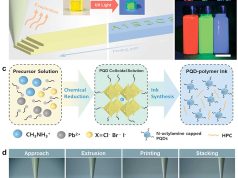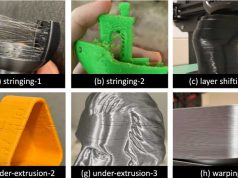Researchers at the Korean Electronics Research Institute (KERI) have developed a 3D printing technology for transparent displays and AR devices. The physical principle of structural colors in nature, as known from chameleons or peacock feathers, is technically implemented. With the help of a 3D-printed diffraction grating, the path of light can be specifically controlled.
A team led by Dr. Jaeyeon Pyo developed a three-dimensional diffraction grating that can precisely control the path of light based on ‘nanoscale 3D printing technology’. This uses the principle of structural color observed in nature for advanced display technology.
When light hits a microstructure in wavelength plane, it bends and changes its path. For regular microstructures, the diffraction results in intense reflections of certain wavelengths of light, resulting in distinct structural colors. For example, the colors of peacock feathers arise from the specific arrangement of their internal microstructure, not from color pigments.
KERI’s achievement is the diffraction grating, which can precisely control structural colors using nanoscale 3D printing technology. This reflects light into different paths depending on the wavelength, which creates a specific structural color or spectrum. It is a 3D printing technology that enables precise light control for vivid color without dyes.
KERI used a new method called ‘lateral printing’ to print a very fine diffraction grating that controls light diffraction, whose wavelength is only 1/1000 the thickness of a human hair.
The demonstrated diffraction grating could be used in numerous advanced display applications, from transparent displays such as smart windows to AR devices. In addition, diffraction gratings that emit different colors depending on how they are deformed could be used in mechanical and biomedical engineering.
Dr. Jaeyeon Pyo of KERI said that this is “the world’s first 3D printing technology that accurately implements the desired structural color in the desired location without restrictions on the material or shape of the substrate.”
He added that this technology will be able to overcome the formulaic ‘Form-Factor’ limitations of display devices and bring about diversification of shapes.
KERI has already filed a patent for the technology and plans to support companies interested in this technology with technology transfers.
Subscribe to our Newsletter
3DPresso is a weekly newsletter that links to the most exciting global stories from the 3D printing and additive manufacturing industry.


























